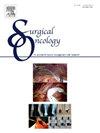Comparative analysis of hepatectomy for HCC with PVTT: Insights from a 30-year single-center experience
IF 2.4
4区 医学
Q3 ONCOLOGY
引用次数: 0
Abstract
Background and aim
Portal vein tumor thrombosis (PVTT) is frequent in hepatocellular carcinoma (HCC). Although hepatectomy is the primary treatment for HCC, no consensus exists on its role in PVTT between Eastern and Western clinicians. This study aims to assess the efficacy of hepatectomy in HCC patients with PVTT by analyzing perioperative outcomes and prognosis.
Methods
This retrospective, single-center study reviewed HCC patient data from Queen Mary Hospital, Hong Kong (1989–2020). Propensity score matching (PSM) was applied to match patients with and without PVTT undergoing hepatectomy, comparing perioperative and survival outcomes between groups.
Results
Among 3981 HCC patients, 1842 had PVTT and were not operated (not-operated group), while 2139 underwent hepatectomy. Of the operated patients, 156 had PVTT (PVTT group) and 1983 did not (no-PVTT group). Median overall survival (mOS) in the not-operated group was 2.7 months, compared to 13.0 months in the PVTT group. After 1:3 PSM, the no-PVTT group (n = 468) had longer mOS (47.0 vs. 13.0 months, p < 0.001) and disease-free survival (10.6 vs. 4.2 months, p < 0.001). The PVTT group had longer operative times (449 vs. 390 min, p < 0.001), higher complication rates (37.8 % vs. 28.2 %, p = 0.024), and closer surgical margins (0.6 vs. 1.0 cm, p = 0.036), but similar hospital mortality (p = 0.898). mOS for low-AFP (<17400 ng/ml) and high-AFP (≥17400 ng/ml) patients was 16.2 vs. 8.2 months, respectively (p < 0.001).
Conclusion
Aggressive treatment of PVTT is necessary. For certain PVTT patients, hepatectomy may be potentially effective, with acceptable perioperative safety and seemingly no technical barriers.
肝切除术与PVTT治疗HCC的比较分析:来自30年单中心经验的见解
背景与目的门静脉肿瘤血栓形成(PVTT)是肝细胞癌(HCC)的常见病。虽然肝切除术是HCC的主要治疗方法,但东西方临床医生对其在PVTT中的作用尚未达成共识。本研究旨在通过分析肝切除术对肝细胞癌合并PVTT患者围手术期预后的影响,评价肝切除术对肝细胞癌合并PVTT患者的疗效。方法本回顾性单中心研究回顾了香港玛丽医院1989-2020年HCC患者资料。采用倾向评分匹配(PSM)对行肝切除术的PVTT患者和不PVTT患者进行匹配,比较两组患者的围手术期和生存结果。结果3981例HCC患者中,1842例行PVTT且未行手术(非手术组),2139例行肝切除术。手术患者中有PVTT 156例(PVTT组),无PVTT 1983例(无PVTT组)。未手术组的中位总生存期(mOS)为2.7个月,而PVTT组为13.0个月。1:3 PSM后,无pvtt组(n = 468)的mOS延长(47.0 vs 13.0个月,p <;0.001)和无病生存期(10.6个月vs. 4.2个月,p <;0.001)。PVTT组手术时间更长(449 vs 390 min, p <;0.001),更高的并发症发生率(37.8%对28.2%,p = 0.024),手术切缘更近(0.6对1.0 cm, p = 0.036),但医院死亡率相似(p = 0.898)。低afp (<17400 ng/ml)和高afp(≥17400 ng/ml)患者的最小生存时间分别为16.2个月和8.2个月(p <;0.001)。结论积极治疗PVTT是必要的。对于某些PVTT患者,肝切除术可能具有潜在的有效性,具有可接受的围手术期安全性,似乎没有技术障碍。
本文章由计算机程序翻译,如有差异,请以英文原文为准。
求助全文
约1分钟内获得全文
求助全文
来源期刊

Surgical Oncology-Oxford
医学-外科
CiteScore
4.50
自引率
0.00%
发文量
169
审稿时长
38 days
期刊介绍:
Surgical Oncology is a peer reviewed journal publishing review articles that contribute to the advancement of knowledge in surgical oncology and related fields of interest. Articles represent a spectrum of current technology in oncology research as well as those concerning clinical trials, surgical technique, methods of investigation and patient evaluation. Surgical Oncology publishes comprehensive Reviews that examine individual topics in considerable detail, in addition to editorials and commentaries which focus on selected papers. The journal also publishes special issues which explore topics of interest to surgical oncologists in great detail - outlining recent advancements and providing readers with the most up to date information.
 求助内容:
求助内容: 应助结果提醒方式:
应助结果提醒方式:


